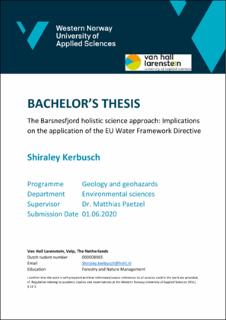| dc.description.abstract | The current EU Water Framework Directive (WFD) classification of the Barsnesfjord is “Bad”. The final WFD classification includes within the biological quality elements only the Shannon Index (H’) of benthic macro-invertebrates. The chemical quality elements showed a “Very bad” WFD classification based solely on mercury (Hg) found in fish in the distant Aurlandsfjord and Sognefjord outside Balestrand. The analyses of this classification occured exclusively in space. The improved classification of this thesis increases the amount of quality elements and data. The parameters used for this new Barsnesfjord WFD classification are (a) Biological quality elements: Macro-algae (RSL/RSLA), benthic macro-invertebrates (ES100, H’, NQI 1, ISI2012, NSI), benthic foraminifera (ES100, H’); (b) Chemical quality elements: Inorganic pollutants (trace metals As, Cd, Cr, Cu, Hg, Ni, Zn) and organic pollutants (PAHs, PCBs, TBT); and (c) Physical quality elements: Oxygen and transparency. The analyses of the improved classification of this thesis occurs in space and, where possible, in time (i.e. benthic foraminifera, pollutants and oxygen). The improved classification of this thesis defines the Barsnesfjord at a “Bad” WFD environmental status with NSI and ISI2012 included, and at a "Very bad" WFD environmental status with NSI and ISI2012 excluded. A reason for excluding the NSI and the ISI2012 is that the classification of these two indexes is a result of few, and thus less reliable data. The improved classification of this thesis also includes a recommendation to define a WFD classification for “Naturally oxygen deficient fjords”, to help controlling the economic aspects involved in the WFD demand of converting the environmental status from “Bad” into “Good” in the Basnesfjord.
Further, the Sogn og Fjordane County Municipality confirmed that the government only has limited knowledge of the current WFD status of the Barsnesfjord. During an interview, two points emerged to increase the awareness of the authorities involved in water management:
• Producing more knowledge about sources and source areas of the parameters leading to the “Bad” environmental status of the Barsnesfjord. This would increase the pressure on politicians and managers to act.
• Make people who work directly or indirectly with water in Norway more aware of the EU Water Framework Directive. This would allow the authorities to incorporate the WFD demands into their own management plans, and thus into their budget.
Finally, this thesis points out beneficial values for the local society, as possible tools in a WFD based water management. The recommendations based on the results of this thesis are:
• Including a classification for “Naturally oxygen deficient fjords” in the Barsnesfjord environmental investigation, thus lowering the costs involved in converting the environmental conditions in the Barsnesfjord from a “Bad” to a “Good” environmental status.
• Starting a campaign on the recreational value of a clean fjord environment to increase the interest of local people in the environmental issues of the Barsnesfjord.
• Focusing on those parameters that need improvement.
• Setting their first priority on stopping further deterioration. | en_US |

